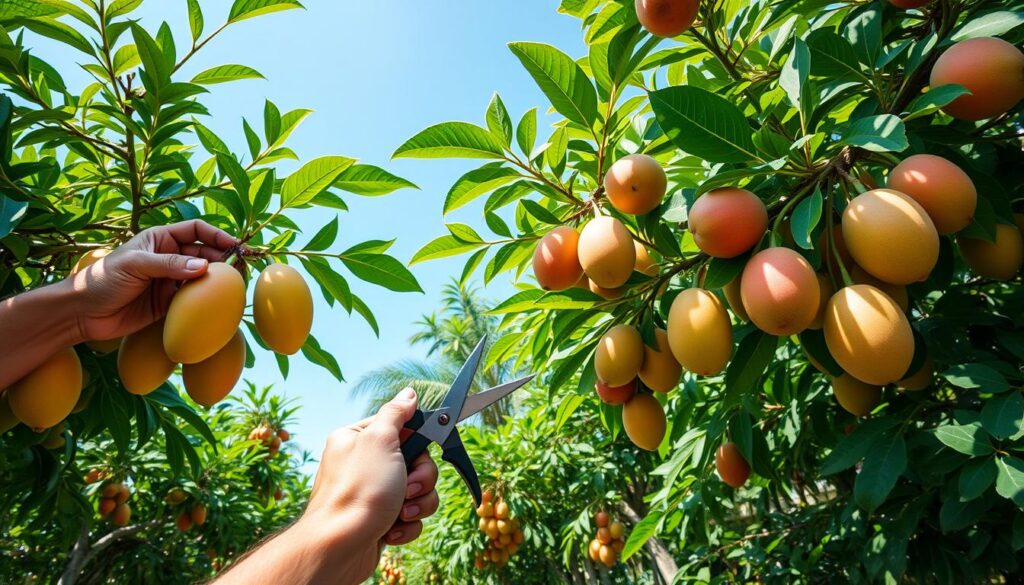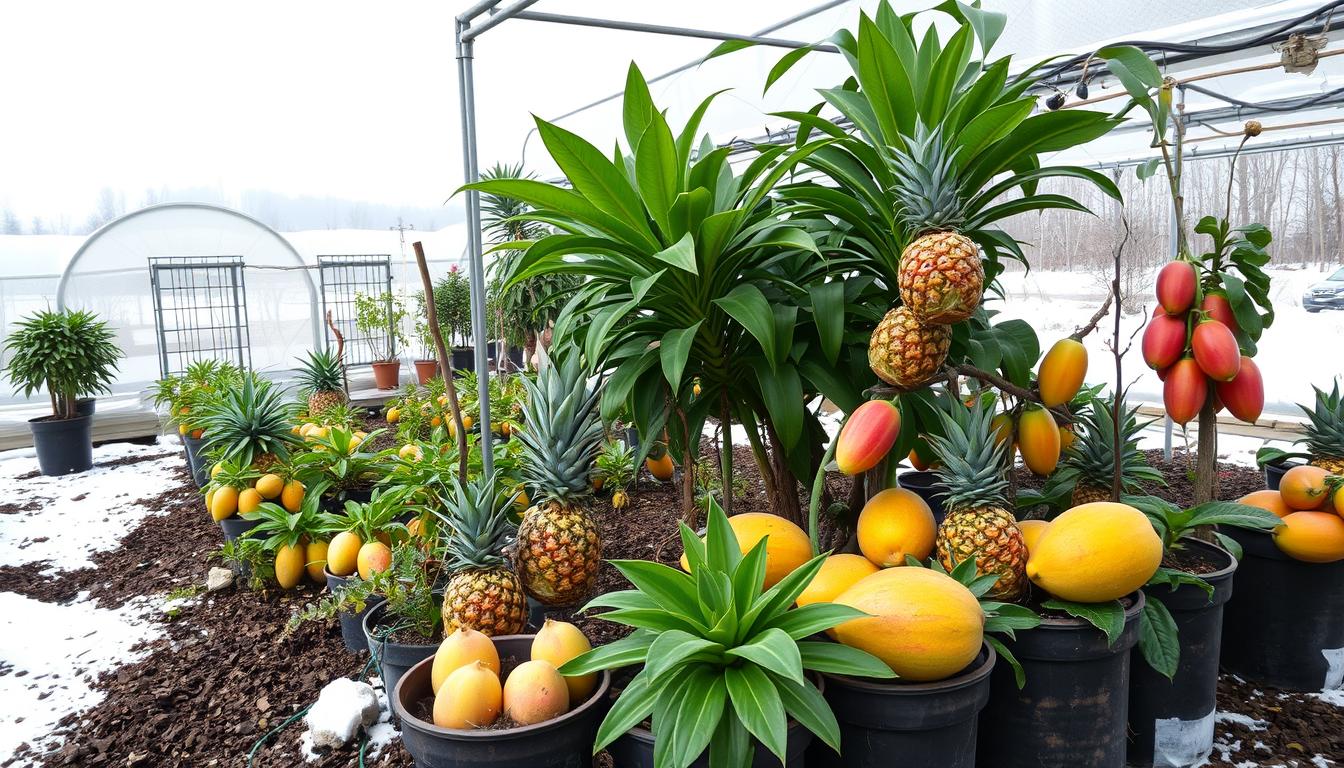Growing tropical fruits in cold climates might seem hard, but it’s doable with the right steps. This guide will help me learn how to grow these fruits in colder areas. We’ll cover picking the right varieties, understanding their needs, and caring for them effectively.
Most tropical plants love warm temperatures, not going below 40°F. So, creating a warm spot for them is key.
We’ll talk about the importance of sunlight, humidity, and good soil. We’ll also discuss how to protect them during winter. Whether it’s bananas, mangoes, or papayas, we’ll go through each step of growing them in cold weather.
Key Takeaways
- Most tropical plants thrive in temperatures above 40°F.
- Container planting can encourage earlier fruit bearing.
- Maintaining humidity is essential for healthy tropical plants.
- Pruning in summer is advisable to promote optimal growth.
- Using high-quality soil and fertilizers can improve plant health.
- Effective winter care includes insulation and proper mulching.
- Reputable nurseries, like Everglades Farm, offer a variety of tropical plants.
Understanding the Basics of Growing Tropical Fruits
Growing tropical fruits needs knowing their special growth needs. They love warm, humid places with temperatures over 40°F. If it’s cold, I use containers to move them and keep them warm.
Many can grow indoors or in special spots that catch sunlight and keep them warm.
Knowing what each fruit needs is key. Mangoes grow well in many soils and are ready from May to September. Pineapples need sandy or loamy soil and take a couple of years to produce fruit. This shows how important soil is for growing these fruits.
Where you place them matters a lot. Fruits like bananas need 6-8+ hours of direct sunlight. So, they need to be in the right spot to get enough sunlight.
Watering in the morning helps use water better and cuts down on waste.
Fruit trees need 16 essential nutrients, with Nitrogen, Phosphorus, and Potassium being the most important. Each nutrient has a special role in growth and fruiting. Choosing the right fertilizers for each plant helps a lot.
Knowing the basics of growing tropical fruits makes gardening rewarding, even in cooler places. By using the right techniques and understanding each fruit’s needs, you can have a bountiful harvest.
Choosing the Right Tropical Fruits for Your Cold Climate
When I think about growing Cold Hardy Tropical Fruits, picking the right ones is key. Some fruits can handle cooler temperatures if we choose wisely. Bananas, guavas, and some citrus fruits are good choices for my garden.
Finding Tropical Fruit Trees that can handle frost is important. For example, Meyer lemons and Windmill palms do well in cold areas. Knowing my USDA Hardiness Zone helps me pick the right Hardy Tropical Fruit Varieties for my climate.
Some fruits, like starfruit and soursops, are harder to find. But knowing this helps me make better choices. Avocados, for instance, grow well in mild temperatures and come in many varieties. Hass avocados are especially popular for their taste.
Smaller fruits often have stronger flavors. This makes choosing fruits like bananas, tomatoes, and blueberries more exciting. I also look for fruits with a strong aroma, like peaches and cantaloupes, to know when they’re ripe.
Knowing when fruits are in season helps me plan my garden. Strawberries come out in spring, followed by cherries and peaches in early summer. Berries show up later in the season. Keeping these in mind helps me get a good harvest. Growing tropical fruits can be tempting, but choosing varieties that fit my local climate is the smart move.
How to Grow Tropical Fruits in Colder Climates
Growing tropical fruits in cold places is a big challenge. Using special winter care is key to keep plants alive and growing well. Knowing these tips helps me get the most out of my garden, even when it’s cold.
Winterization Techniques for Tropical Plants
Winter Tropical Fruit Farming needs the right winter care. Here are some tips that help:
- Insulation: Mulch keeps roots warm in the cold.
- Covers: Blankets or frost covers protect plants from sudden cold.
- Containers: Pots make it easy to move plants inside when it gets too cold.
- Greenhouses: A greenhouse keeps the temperature steady, making it easier to grow Frost-Resistant Fruit Plants.
Indoor vs. Outdoor Growing Options
Choosing between growing indoors or outdoors affects how well you can grow Exotic Fruits. Indoor growing is safer from frost and lets you control the temperature better. Many people grow fruits like star fruit and pineapple guava in pots, which do well indoors.
Outdoor plants face many challenges, like changing temperatures and cold spells. Even the Gulf coast can be too cool for some fruits. Picking cold-hardy varieties, like certain mangoes or Feijoa, can help.

In short, knowing how to care for plants in winter and choosing between indoor and outdoor growing is key. With the right care and choice, I can make my garden fruitful, even in the coldest weather.
Essential Soil and Fertilizer for Tropical Fruits
Knowing the right soil and fertilizer is key for growing tropical fruits. The right essential soil for tropical fruits gives them the nutrients they need. It also helps with water and keeps the soil from getting too wet.
A mix of well-draining soil and organic compost is best. This mix lets roots grow without getting waterlogged.
Types of Soil Ideal for Tropical Fruit Trees
Tropical fruit trees do well in slightly acidic soil with a pH of 5.5 to 6.5. Mangoes need nitrogen-rich soil, while citrus likes organic matter. Good soil management boosts fruit and tree health. It’s important for the soil to hold moisture but not slow down roots.
Fertilizing Techniques for Cold Hardy Tropical Fruits
Fertilizing from spring to summer is key for cold hardy tropical fruits. Use balanced organic fertilizers to help them grow strong. Stay away from chemical fertilizers for the first two years to protect young trees.
Organic compost slowly releases nutrients as it breaks down. This ensures a steady supply of nutrients for tropical fruit cultivation techniques.
| Fruit Type | Ideal Soil Type | Fertilization Frequency |
|---|---|---|
| Mango | Nitrogen-rich, well-draining | Spring and Summer |
| Citrus (Lemon, Lime) | Organic-rich, slightly acidic | Every 6-8 weeks |
| Papaya | Loose, well-aerated | Monthly during growing season |
| Avocado | Rich in organic matter, well-draining | Spring to Fall, bi-monthly |
Using these soil and fertilization methods can make your trees grow and bear fruit in a few years. As I keep learning, I see how it improves my gardening. For more tips, check out Garden Beginner.
Creating a Humid Environment for Tropical Plants
Creating humidity for tropical plants is key for their growth, especially in cold climates. Many tropical fruits come from humid places. I use several methods to keep the air moist around these plants.
Misting plants regularly is a simple yet effective way to add moisture. Using a humidifier is also helpful, especially in dry winter months. Grouping plants together helps create a humid microclimate. But, it’s important to ensure good airflow to avoid mold.
Humidity trays are a great tool for boosting moisture. By placing plants on wet pebbles, I encourage evaporation. This helps keep the air around tropical fruits moist. Keeping humidity at 50% or higher is best for these plants.
There’s a growing need for humid environments for tropical plants, up 15% in five years. Tropical fruit growing in cold climates has increased by 20% in ten years. This is thanks to better greenhouses. Also, 70% of landscapers see more interest in tropical plants, showing a trend towards lush spaces.
Some tropical fruits can grow well indoors, even in cold zones. Plants like kumquats and banana trees can thrive in containers. The Glen mango, for example, can grow up to 10 feet tall. But, it’s manageable in a smaller pot. Proper humidity is crucial, as 80% of tropical plant lovers struggle to replicate tropical conditions indoors.
| Technique | Description | Benefits |
|---|---|---|
| Misting | Regularly spraying water on plants | Provides immediate moisture boost |
| Humidifier | Using an electric device to add moisture | Maintains consistent humidity levels |
| Grouping Plants | Placing plants close to each other | Increases local humidity through transpiration |
| Humidity Trays | Water-filled trays with pebbles for plants | Promotes evaporation to increase moisture |
Container Planting: A Smart Choice for Cold Climates
Container planting is a clever way to grow tropical fruits in cold areas. It lets me grow a variety of fruits, even in USDA Zones 3 and 4. Choosing the right container size and ensuring good drainage are key to keeping my fruit trees healthy.
Selecting the Right Size Containers
For tropical fruit gardening in containers, I prefer containers between 10-15 gallons. They support the trees well and are easy to move indoors when it gets cold. Starting with smaller pots, like 5-7 gallons, makes moving the tree easier as it grows. It’s important to avoid letting the roots get too tangled.
Importance of Drainage in Containers
Good drainage is crucial for growing tropical fruits in containers. I make sure my containers have holes at the bottom or sides to prevent root rot. Using well-draining potting soil helps the roots grow strong. Adding gravel or small rocks at the bottom helps water drain better, keeping my plants healthy.
Winter Care: Protecting Your Tropical Fruits
Winter care for tropical fruits is key to their survival. It’s important to protect them from cold weather. There are specific methods to help them stay healthy.
Methods to Insulate and Heat Your Plants
Insulation is crucial when it gets cold. Here are some effective ways:
- Using row covers and frost cloths traps warmth, keeping plants cozy.
- Move potted plants to a warm spot or use heating mats for a stable temperature.
- Keeping plants moist helps them stay warm. Water in their cells acts as insulation.
The Role of Mulching in Cold Protection
Mulching is another important step. It has several benefits:
- Mulch keeps the soil warm and moist, supporting root health in winter.
- Clean up leaves and fruit to prevent pests and diseases. This reduces disease risk in spring.
- Prune in late winter or spring. This minimizes damage from cold weather.
Choosing hardy varieties like pineapple guava can help. They thrive in zones 8 and possibly 7b. Common guava does well in cooler areas, and picking the right zone is key. Passionfruits, like Passiflora tarmiana, need protection in colder zones.
| Tropical Fruit | Hardiness Zone | Winter Care Notes |
|---|---|---|
| Pineapple Guava | 8, possibly 7b | Requires minimal winter protection |
| Common Guava | 8a, 8b | Thrives in cooler temperatures; zone selection is crucial |
| Maypop Passionflower | 7a | Regrows annually with robust stems |
| Banana Passionfruit | 8a | May need winter protection |
| Passiflora Edulis | 9-12 | Always needs protection in winter |
Using these winter care tips will help your tropical fruits survive and flourish. They’ll be ready to produce a great harvest when it warms up.
Best Practices for Sunlight and Temperature Management
Effective Sunlight Management for Tropical Fruits is key for their growth and yield. Tropical plants love bright spots, needing at least six hours of full sun daily. For those growing indoors, placing plants near south-facing windows or using grow lights helps during winter.
Temperature Control for Tropical Plants is also crucial. They do best in warm weather, usually between the 70s and 90s Fahrenheit. Keeping indoor temperatures above 60°F is important. Cold or freezing temperatures can greatly reduce yields.
Creating a stable growing environment is important. Avoid drafts or heat sources that cause temperature swings. Monitor humidity and ensure good ventilation to prevent fungal infections and pests.
Pruning Techniques for Tropical Fruits
Pruning is key for keeping tropical fruit trees healthy and productive. By using the right pruning techniques for tropical fruit trees, I can manage their growth and keep them vibrant. Different pruning methods help control size, promote new growth, or improve air circulation. Knowing when and how to prune boosts my fruit yields.
When and How to Prune for Healthier Growth
Timing is everything in pruning tropical fruits. I usually prune in winter to encourage spring growth. This lets me spot diseases on bare branches easily. Summer pruning helps keep trees from getting too big, especially fast-growing ones like cherry trees. But I must prune no more than a third to avoid stressing the tree.
Using the right tools like hand pruners, loppers, and saws helps me care for my trees well. Each tool has its own use, making them essential for my orchard’s health. Fruit thinning, for example, can make my harvest bigger and prevent branches from breaking under fruit weight.
Proper pruning has many benefits. It keeps trees healthy, improves air flow, and reduces pests and diseases. Flower pruning also helps trees focus their energy on developing flowers fully. These practices not only boost productivity but also make my orchard safer for nearby structures.

For more on these practices and their effects, check out this affiliate disclaimer. Pruning might seem simple, but it greatly affects my tropical fruit trees’ health when done carefully.
| Pruning Season | Purpose | Benefits |
|---|---|---|
| Winter | Encourage vigorous growth | Identify disease, promote strong branches |
| Summer | Control size | Manage vigorous growth, increase light penetration |
| Late Winter/Early Spring | Prepare for vigorous growth | Select best branches, enhance fruit production |
| Autumn | Discourage pruning | Slow healing, risk for cold damage |
Conclusion
Growing tropical fruits in cold climates is possible with dedication and the right techniques. Smart greenhouse monitor systems are key in managing the conditions needed for these fruits. For example, Japan has grown mangoes and passion fruit, while Canada has grown kiwis and figs.
When growing these fruits, focus on choosing hardy varieties and preparing for winter. Keeping temperatures above 25℃ is crucial for their growth. Techniques like increasing humidity, sun exposure, and nutrient management help them thrive.
With a commitment to learning and growth, you can enjoy fruitful harvests. Growing tropical fruits in cold climates brings joy as you see them flourish with care and understanding.



Leave a Reply